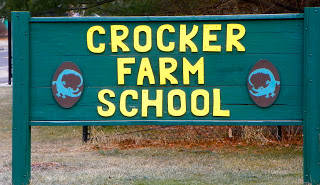RESIDENT CAPITAL REQUEST FUNDED TO STUDY POSSIBLE CROCKER FARM SCHOOL EXPANSION

This Spring, Toni Cunningham and Maria Kopicki, parents of Amherst elementary school children, submitted a Resident Capital Request to study whether it is possible to expand Crocker Farm to accommodate a larger enrollment and at what cost. The $40,000 proposal was reviewed as part of the overall 2020 fiscal year budget process and was approved for full funding by the Town Council on June 17.
The Crocker Farm Expansion Study was put forward because of Superintendent Michael Morris’ proposal to replace both Fort River and Wildwood with a single school of no more than 600 students. At that time, he described four possible routes to “get to 600,” two of which have since been rejected. Middle/High School consolidation was investigated by the Regional Master Facilities Use Study and found to be undesirable and prohibitively expensive. Likewise, the Regional School District Planning Board recommended against joining the Amherst and Pelham elementary school districts.
With these options off the table, the only remaining paths to house Amherst elementary school students in two schools that do not exceed 600 students are: a) decrease the approximately 1100 student (K-6) population by moving 6th graders to the middle school, or b) expand enrollment at Crocker Farm to house the balance. The Middle School Grade Span Advisory Board has been formed to study the former possibility. b) that left expansion of Crocker Farm as the only route unexplored in terms of feasibility and cost. This is what was proposed by Cunningham and Kopicki . In addition, they suggested that a third option be considered that could offer smaller school sizes if 6th grade does move to ARMS, namely dividing the remaining 960 (K-5) students into roughly equal enrollments of two 480-student schools.
Beyond assessing how much additional enrollment the Crocker Farm campus can accommodate, the proposed study would also provide feasibility and cost analysis of addressing existing heating/cooling, accessibility, and other infrastructure needs of Crocker Farm (including the gymnasium, which is approximately half the size recommended by the state.)
Even if the decision is made to keep Crocker Farm at its current size (~360 K-6 plus ~70 PreK students), this study would determine if it is possible to expand if overall enrollment increase in the future. Kindergarten enrollment at Fort River jumped significantly this year, possibly due to the new Dual Language program that will begin in the fall, and the university/college may continue to grow, bringing in more families with young children, putting Superintendent Morris’ 600 student maximum at risk if Crocker Farm cannot take on additional students.
While funding for the study has been appropriated, Town and District leaders must take action for the study to commence. Cunningham and Kopicki have asked that quotes for this study be solicited in summer 2019, with the goal of completing the work by early fall 2019. Such work would likely be done by an architectural firm like TSKP (from the Fort River school building project) or JCJ (the ones who did the Wildwood design and the middle and high school study). Cunningham and Kopicki contend that the information should be gathered prior to the state decision-making (November/December 2019) regarding Amherst’s Statements of Interest as it would demonstrate to the Massachusetts School Building Authority Amherst’s commitment and readiness. In addition, the study may determine that expansion of enrollment at Crocker Farm school is limited, thereby clarifying options for elementary school infrastructure and middle school grade span. They suggest that the more information that can be gathered before the high pressure and possible politicization of an MSBA process and/or an election season for School Committee begins, the better.
Kopicki and Cunningham suggest that understanding the possible approaches to the town’s elementary schools and their costs is critical to wider decision-making for the town’s overall capital project needs. The cost estimate most recently used by the town for a Crocker Farm expansion from ~360 to 560 students was only $5 million dollars. However, Kopicki pointed out that this figure only reflects the current cost of additional classrooms and does not account for the needs of the school as a whole (larger common spaces, grossing factor, parking, mechanical and other systems, etc.). A building assessment and cost analysis by a design firm could provide more accurate information which, when combined with the 6th grade study and the final product of the Fort River Feasibility Study, will provide the information needed to weigh all options to address the elementary schools.
